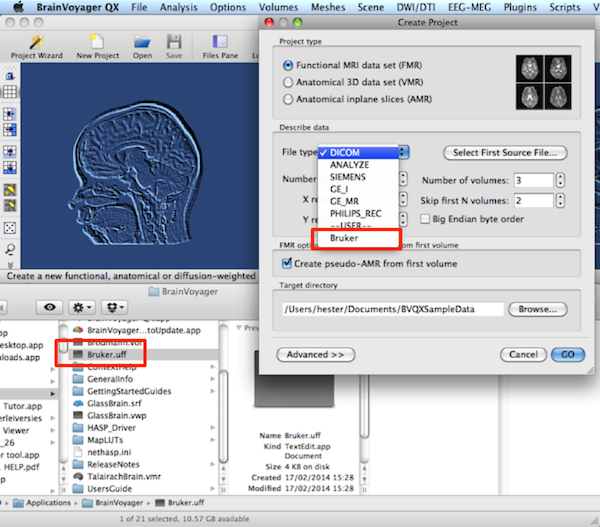The format of UFF files
- Details
- Category: File Formats
- Last Updated: 27 March 2018
- Published: 27 March 2018
- Hits: 5224
About user-defined files (*.uff)
Besides DICOM (*.dcm), Philips (*.PAR, *.REC) and GE (*.MR, *.I) and other file formats, it is also possible to read a file using a user defined format (*.uff) when creating a BrainVoyager project (*.vmr, *.dmr, *.fmr, *.amr). The *.uff file is a simple text file describing features of the data like header size, number of columns and rows, etc. The UFF format could for example be used for Bruker data.
Document describing user-defined file formats (*.uff): theformatofufffiles_v02.pdf ; this document includes a Matlab script to create such an *.uff file.
Example UFF file: example_uff_file.zip
Matlab script to create UFF file: createUFF.zip
How to use the UFF file in BrainVoyager
The *.uff file should be stored in the BrainVoyager directory (/Applications/BrainVoyager/); when starting a "New Project" in BrainVoyager, the names of *.uff files in the BrainVoyager directory are added to the known file formats (see figure below).

The format of UFF files
|
UFF file parameter |
Sample values |
Description |
|
|
|
|
|
FileVersion: |
2 |
Describes file version of UFF format |
|
NSpalten: |
128 |
Number of columns |
|
NZeilen: |
64 |
Number of rows |
|
HeaderSize: |
0 |
Size of image header |
|
PixelFormat: |
1 |
Datatype, defining number of bytes per pixel 1 = 1 byte integer 2 = 2 bytes integer 3 = 4 bytes integer 4 = 4 bytes float |
|
DICOM: |
0 |
Boolean value defining whether the datatype conforms to the DICOM standard or not. 0 = no, 1 = yes. |
|
SwapBytes: |
0 |
Boolean value defining whether the data should be swapped or not. Default is 0 (little endian). Big endian data should have value 1. |
|
Explicit VR: |
0 |
Explicit value representation (only applicable in case of DICOM) |
|
MultiImageFile: |
1 |
Defines whether there are more than one images in the file. 0 = no, 1 = yes. |
|
SubHeaderSize: |
0 |
In case of a multi-image file, defines whether each image in the file does have a header (1) or not (0). |
|
ImageIndex: |
1 |
First image to be read from the multi-image volume |
|
SingleFuncType: |
|
Defines order of appearance of the dimensions in the file. 1 = slices x time (single file) 2 = time x slices (single file) 3 = N slice files 4 = N volume files |
|
TimeRunsFastest: |
0 |
Defines whether all timepoints per pixel or voxel appear before the next pixel or voxel values. If yes, then 'TimeRunsFastest' should be 1, 0 otherwise. |
